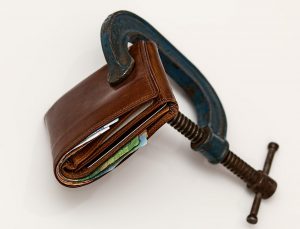You are the master of your budget. Well, you’re trying to be at least, and you have the best of financial intentions. So what happens when those awkward financial situations come up? You know what we’re talking about: your friend invites you to a party where she’s selling kitchenware, a charity worker comes to your door asking for donations, your coworker’s kid is having a fundraiser, or your friends want to go to a super expensive restaurant. Saying that one teeny tiny word “no” can feel like the hardest thing to do, and you might end up giving in more often than you’d like, simply to avoid that icky feeling of saying it. But all of those yeses can add up and start to eat away at your budget! You need some strategies for saying a hard financial “no” in difficult situations, so you can stick to your budget and reach your goals when it comes to saving and spending.
Tell Them About It

We’ve already established that you’re on a budget, and that’s great! And you know what? While you certainly don’t have to disclose all of your personal financial information to your friends and family, it’s perfectly ok to have this one important phrase in your arsenal: “I’m on a budget.” Feel free to add the word “strict” or “tight” to that sentence; however you phrase it, it’s hard for someone in your life to argue against boundaries you’ve set for yourself.
Consider being proactive and talking about your budget with friends and family, so they’ll already be aware of it, and will be more likely to accept your final answer when you’re asked to spend. If the request is something like an invitation to an expensive dinner out, you can always thank them, express your desire to go, and tell them that you’ll budget their request for next month!
Practice Makes Progress
How do you get to Carnegie Hall? Practice, practice, practice! How do you get more comfortable with saying “no?” The same way! It might sound silly to practice that one simple word, but a lot of people need to work on it – it’s not easy to refuse requests; it can feel almost embarrassing for us, or like we’re going to hurt the other person’s feelings. But some financial experts suggest that you can start small, and build up a type of resistance to this discomfort, which will eventually make it easier for you to say a guilt-free “no” to any financial request.

Practice saying “no” out loud (try it – it might even feel a bit funny!), and use your power of refusal in small situations. For example, if you don’t want to contribute to someone asking for charity contributions on the street every time you pass them, practice looking them in the eye as you pass and politely saying, “No, I’m sorry, I already contributed yesterday and won’t be contributing again this week/month/year.” Or, if you’re always asked to participate in a gift exchange but it isn’t in your budget, offer a polite “No, sorry, not this year, I’ve already used up my gift budget.” Getting used to these simple, polite – but maybe slightly uncomfortable – refusals will build up your tolerance to using the word “no” and the reaction it elicits, and you’ll be able to handle any awkward financial situation!
Maybe Later…
Learning to say a firm “no” is a great idea, but you don’t always have to say no in every situation. Sometimes simply deferring until later is an acceptable strategy: you can say that you appreciate the offer, but now is not the right time, and you’ll reach out when you can swing things. This will buy you some time (no pun intended!) and put you back in control of the situation. If you’re being asked for a contribution, put off saying “yes” by telling the person you will look into their organization and might make a donation at a later date.
Your Money, Your Choice
Just as you might need to practice saying a firm “no,” you might also need some practice reminding yourself that if a situation involves your money, it is your choice whether you want to hand over that hard-earned dough. Do you really want to participate in all of those fundraisers that your coworkers’ kids pass around, or do you want to buy every box of Girl Scout cookies that your acquaintances are trying to unload? Probably not, so assess the situation, decide if you want to decline (and how you feel about possibly being the only one to say no), and stand up to the peer pressure if need be. You can use the old “I’ve already made all my donations for this month/year” line, or you can simply decide to opt out of participating in any of these activities. You just have to do a cost/benefit analysis, remembering that you get to choose what you do with your money.
Find Another Way
Financial requests are coming at you from every direction, and maybe you want to help, contribute, or join in but, again, that pesky (and very responsible) budget of yours is just making it impossible. So if you truly want to be a part of these situations, why not offer other, non-monetary solutions? For example, someone with a worthwhile charity comes right to your door to ask for a contribution (always a tough one!): you could try the putting it off until later strategy (“I’ll check out your website and decide if I’d like to contribute”), or the it’s my money, my choice strategy and simply tell them no, you’ve already allocated all of your charitable funds for the year. Or, if you’re really interested in helping this particular charity, say you’d like to help but are unable to do so financially, and ask them for information on volunteering. Another example: your friend is holding one of those parties where they’re going to sell kitchenware, lingerie, books, etc and you know you don’t want to spend any money on those things, but you want to be there for your friend. So tell them that! Talk to your friend and find out why they’ve really invited you: it might simply be that they’re nervous about hosting the party and would love to have a familiar face there. Offer to go and be their support and help them host!
Another example: your friend is holding one of those parties where they’re going to sell kitchenware, lingerie, books, etc and you know you don’t want to spend any money on those things, but you want to be there for your friend. So tell them that! Talk to your friend and find out why they’ve really invited you: it might simply be that they’re nervous about hosting the party and would love to have a familiar face there. Offer to go and be their support and help them host!
And if it’s something you really would like to do, like go out with your friends for dinner? Suggest other, cheaper options, like going out for coffee, dessert, drinks – or, better yet, suggest a potluck that you can all have fun contributing to. And if their hearts are set on that expensive dinner out, offer to go along as company, but make it clear that you’ll just be having a drink and helping out with the tip.
Be Honest with Yourself and Others
In the end, honesty is the best policy, right? You don’t have to lie to anyone to get out of spending your own money; you can use gentle deferrals, alternative suggestions, or just a polite, firm “no” to save yourself from financial hardship. Sometimes, though, “no” can be an invitation to salespeople to try even harder, so be ready to tell them honestly that it’s really “no can do” right now.
Remember, it’s just as important to be honest with yourself about your finances as it is to be honest with others about what you can afford or want to spend. Regularly assess your budget and consider trying a system that helps you really know how much you have for the types of requests we’ve looked at above. For example, use a budgeting app if you’re into tech; if you’re looking for an effective, analogue system, try putting money into different envelopes for different types of expenses: when you run out of money for each thing, you can honestly say to yourself – and others – that you don’t have anything left in your budget for that!
When it comes to sticking to your budget, we know you can do it! There might be bumps in the road, like when you come across situations where it can feel awkward to say “no” to spending, but with a few strategies and a little practice you can avoid getting off track. So get out there, practice your “no”s, and release yourself from the guilt of not spending your hard-earned money.



